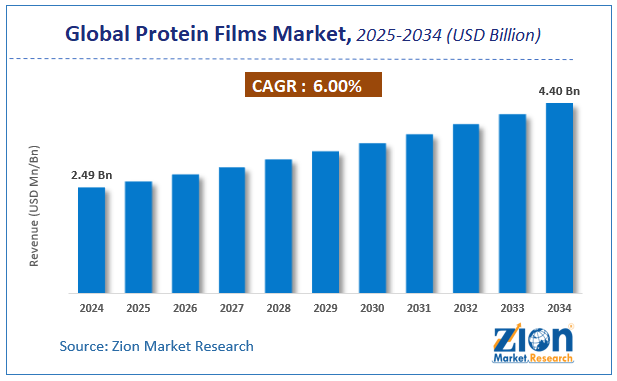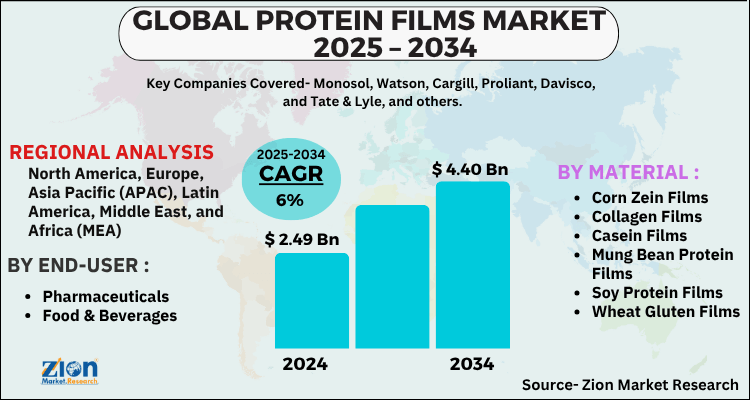Global Protein Films Market Size, Share, Growth Analysis Report - Forecast 2034

Protein Films Market By End-User (Pharmaceuticals, Food & Beverages), By Material (Corn Zein Films, Collagen Films, Casein Films, Mung Bean Protein Films, Soy Protein Films, Wheat Gluten Films, and Others), and By Region: Global and Regional Industry Overview, Market Intelligence, Comprehensive Analysis, Historical Data, and Forecasts 2025 - 2034
| Market Size in 2024 | Market Forecast in 2034 | CAGR (in %) | Base Year |
|---|---|---|---|
| USD 2.49 Billion | USD 4.40 Billion | 6% | 2024 |
Protein Films Market Size
The global protein films market size was worth around USD 2.49 Billion in 2024 and is predicted to grow to around USD 4.40 Billion by 2034 with a compound annual growth rate (CAGR) of roughly 6% between 2025 and 2034.
The report analyzes the global protein films market's drivers, restraints/challenges, and the effect they have on the demands during the projection period. In addition, the report explores emerging opportunities in the protein films industry.
Protein Films Market: Overview
Protein films are used to prevent food against microbial growth, and biological deterioration. They have extensive applications in controlling the migration of moisture as well as nutrient oxidation, thus contributing to the overall improved efficiency of packed food products. Multiple studies have suggested that protein-based films are efficient methods of drug delivery, especially the films derived from silk and corn zein owing to their hassle-free extraction which has helped them become a valuable substitute for synthetic products.
Protein films are known to be carriers of antioxidants, antimicrobials, colors, and flavors, which subsequently help in improving the safety and shelf-life of packaged goods. With technological advancements and constant investment in research & development, various proteins are now used to create edible films as well. Some of these proteins include whey, wheat gluten, and mung bean proteins to name a few. Recently, collagen films have gained momentum amongst end-consumers. Collagen is termed a structural protein that is used to connect cartilage, tendons, bone tissue, and ligaments.
Owing to their properties including biocompatibility and non-toxicity, they have been successfully used to manufacture edible films. Various cross-linking agents like carboxamide, transglutaminase, and glutaraldehyde are used to better the thermal and mechanical properties exhibited by collagen films.
Key Insights
- As per the analysis shared by our research analyst, the global protein films market is estimated to grow annually at a CAGR of around 6% over the forecast period (2025-2034).
- Regarding revenue, the global protein films market size was valued at around USD 2.49 Billion in 2024 and is projected to reach USD 4.40 Billion by 2034.
- The protein films market is projected to grow at a significant rate due to increasing demand for biodegradable and sustainable packaging solutions.
- Based on End-User, the Pharmaceuticals segment is expected to lead the global market.
- On the basis of Material, the Corn Zein Films segment is growing at a high rate and will continue to dominate the global market.
- Based on region, North America is predicted to dominate the global market during the forecast period.
Protein Films Market: Growth Drivers
Growing demand for safe food packaging to drive market growth
The global plastic films market is projected to grow due to increasing demand for safe packaging in the food & beverages industry. Effective and efficient food packaging solutions and options play a major role in the development of the current food sector as very limited food items are currently being sold unpacked.
A packaging system is considered coherent when it is capable of preventing wastage while also ensuring that the desired quality of the food is retained throughout the shelf life. Due to growing awareness amongst consumers about the environmental impact of poor packaging systems like non-biodegradation, there is a growing request for environment-friendly food packaging protocols. Protein films are environment-oriented and are becoming a preferred choice amongst the players in the F & B sector.
Protein Films Market: Restraints
Need for external agents to improve mechanical properties may restrict market expansion
The global market is anticipated to witness restrictions in growth due to the product lacking effective mechanical properties and the requirement of additional agents for the product to exhibit the desired level of mechanical properties. These aspects include healing properties, thermal stability, toughness, and mechanical strength. Since protein films do not inherently exhibit strong properties and need external assistance, this fact has been acting as a roadblock in the otherwise smooth growth trajectory of such films. However, there has been growing advancement in the field of nanotechnology to help improve the tensile strength of protein films to make them more reliable.
Protein Films Market: Opportunities
Increasing investment in the packaging field to provide excellent growth opportunities
With the growing population and the increase in demand for consumables, the packaging industry is under extreme pressure to cater to the requirement along with the need to constantly upgrade packaging solutions to keep up with the changing dynamics of consumer expectations. This has eventually led to a growth in investments either for product innovation or R & D. Market players are investing in developing cost-efficient and exceptionally functional packaging materials while also developing more eco-friendly substitutes like protein films.
Protein Films Market: Challenges
Incomplete hydrophobia a challenge for market expansion
Protein films are not completely hydrophobic and mostly contain hydrophilic amino acids which subsequently reduced their barrier properties for moisture. To create edible protein films that exhibit low water vapor permeability, additional hydrophobic components have to be added resulting in increased cost and a long process. Protein films also require denaturing using either acid, heat, bases, or other solvents.
Protein Films Market: Segmentation
The global protein films market is segmented by end-user, material, and region
Based on end-users, the global market is segmented into pharmaceuticals, food & beverages. In 2021, the global market witnessed the highest revenue in the food & beverages sector. In 2014, the F & B sector held more than 40.1% of the global market sector. The market is anticipated to be propelled by growing consumer awareness and health concerns. Increasing the use of functional food owing to its nutritional value may also assist in generating a larger consumer database. The pharmaceutical sector is projected to grow at a high CAGR due to the application of protein films to cater to the needs of diabetic patients along with infection prevention and wound dressing.
Based on material, the global protein film market segments are corn zein films, collagen films, casein films, mung bean protein films, soy protein films, wheat gluten films, and others. The global market may be dominated by corn zein films in the coming years along with high demand for soy, wheat gluten, and collagen films owing to their low oxygen permeability as compared to starch-based films. Corn zein films are one of the most versatile materials to be used in the F & B sector.
Protein Films Market: Report Scope
| Report Attributes | Report Details |
|---|---|
| Report Name | Protein Films Market |
| Market Size in 2024 | USD 2.49 Billion |
| Market Forecast in 2034 | USD 4.40 Billion |
| Growth Rate | CAGR of 6% |
| Number of Pages | 205 |
| Key Companies Covered | Monosol, Watson, Cargill, Proliant, Davisco, and Tate & Lyle, and others. |
| Segments Covered | By End-User, By Material, and By Region |
| Regions Covered | North America, Europe, Asia Pacific (APAC), Latin America, The Middle East and Africa (MEA) |
| Base Year | 2024 |
| Historical Year | 2020 to 2023 |
| Forecast Year | 2025 - 2034 |
| Customization Scope | Avail customized purchase options to meet your exact research needs. Request For Customization |
Recent Developments:
- In June 2022, a group of researchers from the Institute of Advanced Study in Science and Technology (IASST), India, developed ultrathin monolayer protein films made of globular proteins, namely: lysozyme (Lys) and bovine serum albumin (BSA). The newly developed film exhibits high mechanical and thermal qualities along with excellent pH stability which is expected to garner more growth opportunities in the F & B sector
- In June 2022, Xampla, a University of Cambridge spin-out launched a next-generation protein material made of the plant to be used for commercial purposes in place of synthetic polymers but with natural decomposition properties and no harmful impact on the environment
Protein Films Market: Regional Analysis
Asia-Pacific to witness the highest growth during the forecast period
The global protein film market is anticipated to witness the highest growth in Asia-Pacific due to the increasing consumer awareness about the consumption of healthy food and changing consumer patterns. The growing F & B sector of countries like China, India, Singapore, Japan, and others are projected to become heavy contributors toward regional growth which may be further propelled by the rise in investment in R & D in the food sector. For instance, in 2021, India’s food sector generated a revenue of USD 8320 million along with excellent growth opportunities.
One of the major reasons for such high revenues is the economic reform policies adopted by regional governments to meet the growing demand for food due to the exponentially rising population. The fast-moving consumer goods (FMCG) sector is considered the fourth largest economic sector in India and the increasing rate of strategic decisions by Indian players like global tie-ups and collaboration may further fuel the regional market growth.
Protein Films Market: Competitive Analysis
The report provides a company market share analysis to give a broader overview of the key market players. In addition, the report also covers key strategic developments of the market, including acquisitions & mergers, new product launches, agreements, partnerships, collaborations & joint ventures, research & development, and regional expansion of major participants involved in the protein films market on a global and regional basis.
The global protein films market is dominated by players like:
- Monosol
- Watson
- Cargill
- Proliant
- Davisco
- and Tate & Lyle
The global protein films market is segmented as follows;
By End-User
- Pharmaceuticals
- Food & Beverages
By Material
- Corn Zein Films
- Collagen Films
- Casein Films
- Mung Bean Protein Films
- Soy Protein Films
- Wheat Gluten Films
- and Others
By Region
- North America
- The U.S.
- Canada
- Mexico
- Europe
- France
- The UK
- Spain
- Germany
- Italy
- Rest of Europe
- Asia Pacific
- China
- Japan
- India
- Australia
- South Korea
- Rest of Asia Pacific
- The Middle East & Africa
- Saudi Arabia
- UAE
- Egypt
- Kuwait
- South Africa
- Rest of the Middle East & Africa
- Latin America
- Brazil
- Argentina
- Rest of Latin America
Table Of Content
Methodology
FrequentlyAsked Questions
The global protein films market is expected to grow due to rising demand for biodegradable and edible packaging solutions, increasing focus on sustainable alternatives, and growing applications in the food industry.
According to a study, the global protein films market size was worth around USD 2.49 Billion in 2024 and is expected to reach USD 4.40 Billion by 2034.
The global protein films market is expected to grow at a CAGR of 6% during the forecast period.
North America is expected to dominate the protein films market over the forecast period.
Leading players in the global protein films market include Monosol, Watson, Cargill, Proliant, Davisco, and Tate & Lyle, among others.
The report explores crucial aspects of the protein films market, including a detailed discussion of existing growth factors and restraints, while also examining future growth opportunities and challenges that impact the market.
RelatedNews
HappyClients
Zion Market Research
Tel: +1 (302) 444-0166
USA/Canada Toll Free No.+1 (855) 465-4651
3rd Floor,
Mrunal Paradise, Opp Maharaja Hotel,
Pimple Gurav, Pune 411061,
Maharashtra, India
Phone No +91 7768 006 007, +91 7768 006 008
US OFFICE NO +1 (302) 444-0166
US/CAN TOLL FREE +1 (855) 465-4651
Email: sales@zionmarketresearch.com
We have secured system to process your transaction.
Our support available to help you 24 hours a day, five days a week.
Monday - Friday: 9AM - 6PM
Saturday - Sunday: Closed






